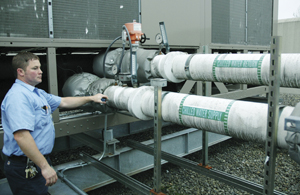To hunt for big savings in water consumption, be vigilant in searching for leaks and waste in the labyrinth of industry-sized systems that power a hospital.
That's the advice of Geoffrey Glass, director of facility and technology services for Providence St. Peter Hospital in Olympia, Wash. Over a decade, the hospital has reduced by half its annual water consumption, down from 62 million gallons, allowing for major savings both in water and sewer bills — $312,264 in 2012 alone.
The hospital has managed that reduction even as the campus of the 340-bed hospital has been expanded by nearly 20 percent.
"Our mantra is 'A penny a gallon,'" Glass said. "In everything we do, our common vision is water conservation."
The hospital has installed low-flow toilets, urinals, sinks and shower heads, saving about 3.6 million gallons of water annually. Plenty of hospitals and other businesses, large and small, have had similar relative success. And Glass said the savings in water from the new devices hadn't been as much as he had hoped.
But Providence St. Peter also saved 1.5 million gallons per year by fitting its irrigation systems with weather sensors — meaning no more sprays on rainy days — and by constantly looking for and fixing leaks. That has cut outside water use by 75 percent, Glass said.

Cameron Clark, facility technician at Providence St. Peter Hospital, checks on an air-cooled chiller, which saves water on air conditioning.
"Go for what I call the 'industrial things' — heating, cooling, refrigeration, food service," he said. "You can be flushing down water from your heating system and, on a large hospital campus, you may not even know it. Then there are systems with high use that were built back when water costs weren't that major a consideration."
With water and sewer costs rising everywhere — they have doubled in Olympia since 1998 — it has become a major incentive for conservation.
An example: Providence St. Peter saved 3.8 million gallons per year by refitting the steam and cooling systems on its large sterilizers. Condensed steam now is returned to the boiler system rather than being flushed. The same thing goes for the water used to cool the sterilizers. "All of that water had been going down the drain," Glass said.
Any savings in water consumption by a hospital's main air-conditioning system will be substantial, he said. That system, including the big cooling towers on the roof, accounts for about 10 percent of Providence St. Peter's water bill.
Some of that water leaves the chiller through evaporation, which is a necessary part of the process and doesn't count against the sewer bill. But with all that water, fixing even relatively small leaks provides big savings, Glass said. When combined with other improvements to the chiller, water consumption is down about 600,000 gallons annually.
Here are other ways Providence St. Peter saves water:
Using air systems rather than cold water to cool the machinery that provides compressed air and vacuum throughout the hospital, for a reduction of almost 2 million gallons annually.
Upgrading dishwashing systems in food service. At Providence St. Peter, the new system uses 657,000 fewer gallons of water annually.
Replacing "single-pass" water-cooled systems such as ice makers and small air conditioners serving individual operations, such as kitchens, pantries and imaging equipment rooms. That water used to run through the machines once and go down the drain.
"Those systems were put there because they were the least expensive to install," Glass said. "Now, every purchasing decision we make involves water consumption."
Glass said the food service department no longer uses its large garbage disposal, another system that uses large amounts of water. Instead, the department captures food waste for composting.
He said more and more hospitals are being increasingly conservation-minded as water and sewer rates climb nationwide. He said reducing the hospital's discharge saves money and honors the facility's mission of stewardship.
"We all must be vigilant about what we are doing to our environment," said Glass.
Medrice Coluccio, chief executive of Providence Health and Services, Southwest Washington, said, "Water-conservation efforts tie directly to our core value of stewardship. Providence strives to care wisely for our resources and our Earth."
World Water Day webinar
CHA, in recognition of World Water Day, is hosting a webinar (free for CHA members) on Feb. 6, from 2-3 p.m. ET, titled, "Water, Water Everywhere? … Our Call as Catholic Health Ministry."
Christiana Z. Peppard, assistant professor of theology, science and ethics at Fordham University, will lead the conversation along with Janet Howard, director of facility engagement at Practice Greenhealth and that organization's Healthier Hospitals Initiative.
Copyright © 2014 by the Catholic Health Association
of the United States
For reprint permission, contact Betty Crosby
or call (314) 253-3477.